Colony Where Androids Malfunction and Kill to Protect Movie
Multiple realities
(covers information from several alternate timelines)
"In his quest to be more like us, he helped us to see what it means to be Human... his wonder, his curiosity about every facet of Human nature, allowed all of us to see the best parts of ourselves. He evolved, he embraced change because he always wanted to be better than he was."
Lieutenant Commander Data was a Soong-type android, the first and only such being to ever enter Starfleet. Data was created some time in the 2330s and was killed in 2379, sacrificing himself to save the crew of the USS Enterprise-E. (TNG: "The Measure Of A Man", "Datalore", "Silicon Avatar", "Conundrum", "Inheritance"; Star Trek Generations ; Star Trek Nemesis )
Contents
- 1 Specifications
- 1.1 Human development
- 1.1.1 Spot
- 1.1.2 Emotion chip
- 1.1 Human development
- 2 Service record
- 2.1 Creation and early life
- 2.2 Discovery and early career
- 2.3 Aboard the Enterprise
- 2.3.1 First year
- 2.3.2 Android rights and freedoms
- 2.3.3 Further service
- 2.3.4 Return to the emotion chip
- 2.4 The Enterprise-E
- 2.4.1 The Ba'ku mission
- 2.4.2 Final days
- 3 Legacy
- 3.1 Simulation
- 4 Personal interests
- 4.1 Holodeck adventures
- 4.2 The arts
- 5 Personal relationships
- 5.1 Friendships
- 5.1.1 Jean-Luc Picard
- 5.1.2 William T. Riker
- 5.1.3 Geordi La Forge
- 5.1.4 Beverly Crusher
- 5.1.5 Worf
- 5.1.6 Katherine Pulaski
- 5.1.7 Children
- 5.1.8 Spock
- 5.2 Romance
- 5.2.1 Natasha Yar
- 5.2.2 Jenna D'Sora
- 5.2.3 Borg Queen
- 5.1 Friendships
- 6 Alternate realities and timelines
- 7 Holograms
- 8 Chronology
- 9 Appendices
- 9.1 Appearances
- 9.2 Background information
- 9.2.1 Academy graduation inconsistency
- 9.2.2 Use of contractions
- 9.3 Apocrypha
- 9.4 See also
- 9.5 External links
Specifications

A diagram of Data's systems
Data was composed of 24.6 kilograms of tripolymer composites, 11.8 kilograms of molybdenum-cobalt alloys and 1.3 kilograms of bioplast sheeting. (TNG: "The Most Toys") All told, his mass was approximately one hundred kilograms. (TNG: "Inheritance") Data's upper spinal support was a polyalloy designed to withstand extreme stress. For instance, Data once leaped into a deep underground cave and was able to safely fall down 11.75 meters to the bottom without damaging himself. (TNG: "The Arsenal of Freedom") His skull was composed of cortenide and duranium. (TNG: "The Chase") His legs were exactly 87.2 centimeters in length. ( Star Trek: Insurrection ) Data was built with an ultimate storage capacity of eight hundred quadrillion bits (100 petabytes) and a total linear computational speed rated at sixty trillion operations per second. (TNG: "The Measure Of A Man") However, he later augmented his computational speed by converting his interlink sequencer to an asynchronous mode of operation, removing the performance constraint created by virtue of having space between his positronic links. His computational speed became virtually instantaneous after this modification. (TNG: "The Quality of Life") Data's construction also included teeth, an artificial tongue and tear ducts. (TNG: "Code of Honor", "The Bonding", "Brothers", "Phantasms", "Thine Own Self"; Star Trek Generations )
His physical and mental capabilities were far superior to that of virtually any organic or cybernetic humanoid, including Klingons, Humans, and even Borg drones. His strength was such that he was capable of casually holding a 1950's automobile at bay against the full force of its engine with a single hand. (TNG: "Emergence") These superhuman capabilities made him an important asset to the Enterprise-D, and the fact that he was either unaffected by or highly resistant to conditions such as disease, radiation, oxygen deprivation, mind control, and chemical imbalance was crucial to the survival of the ship on numerous occasions. (TNG: "Unnatural Selection", "The Vengeance Factor", "Hero Worship", "Clues", "Disaster", "The Game"; Star Trek: First Contact ) However, he was apparently more vulnerable than either Humans or Klingons to atmospheric conditions that involved the presence of high concentrations of ions. For instance, during the Enterprise's mission to Galorndon Core in 2366, Commander Riker noted that had Data been with the away team, the crew would have been "unscrambling his circuits for a week". (TNG: "The Enemy")
As a Soong-type android, Data was incapable of alcohol intoxication, yet components in his processing systems were susceptible to disruption by polywater intoxication. (TNG: "The Outrageous Okona", "The Naked Now") He did not require sustenance, but occasionally ingested semi-organic nutrient suspension in a silicon-based liquid medium to lubricate his biofunctions. (TNG: "Deja Q") Though capable of consuming more traditional food and drink, Data had no sense of taste and therefore tended not to bother eating. (TNG: "Hero Worship") Data also did not sleep, nor apparently did he require rest of any kind. Though he had attempted sleep from time to time, presumably simply to emulate Humans more thoroughly, he appeared to have remained almost constantly active before 2369. After this date, Data suffered an accident which activated a series of circuits in his positronic net that allowed him to experience dreams. After this, he began to sleep regularly in order to experience these dreams. (TNG: "Birthright, Part I") Data also demonstrated immunity to telepathy and other psionic abilities. Deanna Troi could not sense him empathically; nor was he affected by the telepathic broadcasts of the Bendii Syndrome-afflicted Sarek. (TNG: "Night Terrors", "The Game", "Violations", "Phantasms", "Sarek") This was known to trouble him to a certain degree, as he believed that it was possible that there was simply nothing "real" in his mind for these individuals to read; that his consciousness was comprised only of "algorithms and programmed responses". However, the psionically-gifted Betazoid Tam Elbrun vehemently disagreed with this possibility, thinking Data was simply "different". In fact, Tam greatly appreciated this quality in Data, as it meant that he had to talk with Data to understand his personality rather than involuntarily receiving that information telepathically, as tended to be the case when he interacted with other humanoids. (TNG: "Tin Man")
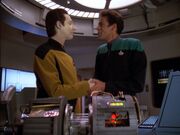
Data and Dr. Bashir
Data had an aging program designed to simulate the external effects of aging in his physical appearance. The blinking of his eyes was governed by a Fourier series, to simulate randomness. (TNG: "Inheritance") In 2369, Dr. Julian Bashir further expressed his fascination for all the trouble Dr. Soong took to make Data seem "Human." He was especially surprised with regard to how "personable" Data was. He also questioned Data about whether his hair grew, and observed that Data was "breathing" and had a "pulse." However, these seemingly aesthetic elements of his person did in fact serve a functional purpose, as his circulatory system was designed to produce biochemical lubricants and regulate micro-hydraulic power, and his respiratory system helped to maintain thermal control of his internal systems. Neither system was entirely necessary however, as Data was known to be capable of functioning for extended periods in a vacuum and was able to withstand exposure to space without suffering any problems. (TNG: "Birthright, Part I", "We'll Always Have Paris"; Star Trek Nemesis )
Data seemed to favor his left hand for tasks such as painting, (TNG: "11001001") using a pen, (TNG: "Time's Arrow") gun tricks, (TNG: "A Fistful of Datas") and more. However, he was completely ambidextrous and was even capable of performing such tasks as painting two pieces at once. (TNG: "Birthright, Part I")
Brent Spiner is left handed.

Data demonstrates his flotation capabilities
Before 2370, Data was apparently incapable of swimming as his body structure was too dense for him to float in water. He apparently learned this through trial and error, as at one point prior to the date in question, he decided to go swimming in Devala Lake while sailing with Geordi La Forge. He immediately sank straight to the bottom, and he ended up having to walk 1.046 kilometers across the lake bed to the shore, as he did not possess enough buoyancy to get back to the surface. It took nearly two weeks to get the water out of Data's servos. (TNG: "Descent, Part II") Data had rectified this problem as of 2375, and installed some sort of flotation device within his body which was buoyant enough to support not only his own weight but that of others. ( Star Trek: Insurrection )
It could be presumed that Data also rectified the problem of water invading his servos, if it was not the prolonged submerging underwater itself that caused it.
Human development
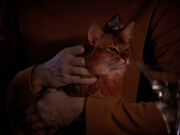
Spot in 2367
Data asserted that he did not only perceive data and facts, but also the "substance" and "flavor" and other ineffable qualities of the experience, which would be lost when downloaded to a conventional computer. (TNG: "The Measure Of A Man")
Data always sought to become more Human in his behavior, sometimes with unfortunate results. His attempts at humor were not successful, nor were his attempts at romance and love. He maintained a relationship with Jenna D'Sora, but it did not last long. (TNG: "In Theory")
Data's comment to the Borg Queen in Star Trek: First Contact regarding how long it had been since he last had sex with a woman would seem to indicate he was referring to Tasha Yar. This suggests that Jenna and Data never had sex during the course of their relationship.
Besides humor and romance, Data also tended to avoid using contractions in regular speech as he had difficulty defining the nuanced occasions on which they were used, although this was part of his programming by Dr. Soong. (TNG: "Conspiracy", "Datalore")
In an alternate timeline, Data appeared to have mastered contractions by the 2390s. (TNG: "All Good Things...")
Spot
During his stay aboard the Enterprise-D, Data kept a cat as his pet, whom he named Spot. Spot was quite fussy in her relationships. Besides Data, she only enjoyed the company of Reginald Barclay. She also had kittens in 2370. In 2371, Spot survived the destruction of the Enterprise. Data, newly imbued with emotions as a result of his emotion chip, cried tears of joy over Spot's survival. (TNG: "In Theory", "A Fistful of Datas", "Force of Nature", "Genesis"; Star Trek Generations )
Emotion chip
Data began using the emotion chip in 2371, about a year after he acquired it from his brother Lore. (TNG: "Brothers", "Descent, Part II"; Star Trek Generations ) At first, he had some difficulties adjusting to the onslaught of emotions, as simple things such as scanning for lifeforms on a planet caused him great pleasure – whereas by contrast, Data was temporarily immobilized with terror when put in a situation where he would experience fear for the first time. He eventually learned to control the feelings. After the initial adjustment period, he was able to activate and deactivate the chip's functioning within his positronic net, and later even to remove it completely in situations where emotions would be a hindrance. ( Star Trek Generations ; Star Trek: First Contact ; Star Trek: Insurrection )
Service record
Creation and early life
Data was constructed on the planet Omicron Theta around 2336. He was the fifth of six known androids designed by Dr. Noonian Soong. The previous, Lore, had been deactivated over the protests of Soong's wife, Juliana. (TNG: "Datalore", "Inheritance") Soong claimed he built Data to perfect his design of his androids, and when Data was perfected, apply his improvements to Lore. (TNG: "Brothers") Juliana had come to view Data as her beloved son, but always feared that he would fail, as his previous "brothers" had, or become dangerous, like Lore, and would have to be dismantled. (TNG: "Inheritance")
In his earliest existence, Data was much like a baby, struggling with motor control and sensory input. (TNG: "Inheritance") Over time, Data had learned about himself and his world, and his programming was refined by Dr. Soong, who attempted to eliminate certain undesirable behaviors. Problems included a disregard for social niceties, courtesies like "please" and "thank you", and a lack of appreciation for clothing, Data did not see any necessity since he "didn't suffer from the elements". In regards to the latter issue, the Soongs had to write a "modesty subroutine", because the colonists objected to an anatomically-accurate android being unclothed. (TNG: "Inheritance")
Eventually Soong decided to feed Data with the logs and journals of the colonists, while simultaneously wiping his memory of his early existence. Unfortunately, while Data was still deactivated, a mysterious Crystalline Entity attacked the colony. (TNG: "Datalore") Juliana's fears that Data would be another failure motivated her to lie to her husband when they fled, forcing him to leave Data behind, inactive. (TNG: "Inheritance")
Data remained alone on the planet, inactive and abandoned by the colonists until he was discovered by a landing party from the USS Tripoli on Omicron Theta.
Discovery and early career
Data was found and reactivated on the planet Omicron Theta by the USS Tripoli on February 2, 2338, after the Crystalline Entity destroyed the entire colony on the planet. (TNG: "Datalore", "Conundrum")
In the first few weeks after Data was reactivated, and without the early presence of Noonien and Juliana Soong, Data claimed he had no one to guide him as his neural net was developing and achieving sentience. (TNG: "The Offspring") In that process, more complex pathways replaced simpler ones. As the integration of these pathways became increasingly difficult, the probability of cascade failure increased. As a consequence, Data considered shutting himself down and beginning all over again. He eventually considered the situation a challenge and continued on. He later expressed to La Forge that, in essence, he considered suicide at a difficult point in his early life. (TNG: "Eye of the Beholder")
His connection with Starfleet resulted in his choice to enter Starfleet Academy. (TNG: "Brothers") Upon applying for admittance to the Academy, Data met with some resistance from Bruce Maddox – who, desiring the opportunity to avail his cybernetic research interests, became, as Data put it, "the only member of the evaluation committee to oppose [Data's] entrance on the grounds that [he] was not a sentient being." Eventually, Data was admitted to the Academy in 2341, and spent four years there. (TNG: "Encounter at Farpoint", "The Measure Of A Man")
Prior to 2364, Data had been cited in several bio-mechanical texts. (TNG: "The Naked Now")
During his time at Starfleet Academy, Data did extremely well scholastically, but his lack of understanding often created social obstacles for him. He fell victim to several practical jokes and had difficulty with social gatherings. (TNG: "The Game") Nonetheless, in 2345, Data graduated, with honors in exobiology and probability mechanics. (TNG: "Encounter at Farpoint", "The Measure Of A Man", "Tin Man")
One of Data's first assignments after he graduated Starfleet Academy was aboard the USS Trieste. (TNG: "Clues") He spent three years as an ensign and twelve as a lieutenant before being promoted to lieutenant commander in 2360. (TNG: "Datalore") In 2364, he was assigned to the USS Enterprise-D as its second officer.
By 2365, he had earned the Starfleet Command Decoration for Gallantry, Medal of Honor with clusters, Legion of Honor, and the Star Cross. These were considered by Wesley Crusher to be "Some of the highest awards in Starfleet." (TNG: "The Measure Of A Man", "The Most Toys") By early 2368, Data had encountered 1,754 non-Human races during his tenure with Starfleet. (TNG: "Darmok")
Aboard the Enterprise
Data served as operations officer and second officer on board the USS Enterprise-D from 2364 until the vessel's destruction in 2371. (TNG: "Encounter at Farpoint", "All Good Things..."; Star Trek Generations ) Since he did not require sleep, he routinely stood night watch on the bridge. (TNG: "Data's Day") His quarters were located on deck 2, room 3653. (TNG: "A Matter of Time") He frequently participated in away missions undertaken by the crew, as was indicated by standard procedure for the second officer of a Federation starship.
First year
Shortly after the Farpoint mission, the Enterprise crew was infected with a polywater intoxication which caused the crew members and even Data to act irrationally, as if mentally unstable. Fortunately, Dr. Crusher found an antidote, and with Data's help the recovered crew was able to retain control of the ship. (TNG: "The Naked Now")
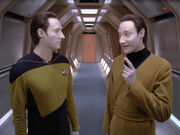
Data gives Lore a tour of the ship
During the Enterprise's first year of active service, it visited the former colony of Omicron Theta, stopping there to investigate the site of Data's discovery. The crew of the Enterprise encountered another Soong-type android in an underground facility, named Lore. Lore was subsequently reassembled and activated aboard the Enterprise. Masquerading as Data, Lore attempted to take control of the ship, but was prevented from doing so by Data. Lore was transported, by Wesley Crusher off the ship, into space (Lore drifted in the interstellar void for two years before being rescued by a passing Pakled trade ship). (TNG: "Datalore", "Brothers")
Later that year, Data took overall command of the Enterprise when the Quazulu VII virus incapacitated the entire crew while in orbit around Angel I. Although the ship had been ordered to the Romulan Neutral Zone, Data's precise and reasoned interpretation of the orders allowed the Enterprise to remain in orbit long enough to rescue the away team members stranded on the planet. (TNG: "Angel One")
Data had been regarded as property by the Ferengi, who wanted to purchase him. He was also referred to as "just a device" by Armus. (TNG: "The Battle", "Skin of Evil") He continued to be regarded as such in 2365 and was even questioned legally as to whether or not he was property of Starfleet.
Android rights and freedoms
Data was a major influence in the process to legally and socially recognize the sentience of Soong-type androids. In 2365, Jean-Luc Picard was asked by Admiral Nakamura on behalf of Commander Bruce Maddox to submit Data to an untested procedure that Maddox believed and had advocated would grant Federation cybernetic science a greater understanding of the technology of Data's positronic brain. Data studied Maddox' proposal and found it to be flawed; persuading William T. Riker and Picard of the legitimacy of Data's position as to the scientific merit of Maddox' project; prompting Maddox to present Nakamura's duly-logged orders requiring Data to submit.
Data refused, and resigned from Starfleet. Maddox challenged Data's right to do so, implying that Data should not be considered a sentient being with rights to self-determination (Louvois reminds Maddox "…we have Rule of Law in this Federation. You cannot simply seize people and experiment on them to satisfy your pet theories!"). Maddox's petition prompted Louvois' supposition of a legal issue as to whether or not Data was property and not to be accorded rights to self-determination ("Would you permit the Enterprise computer to refuse a refit?" Maddox asked Louvois). This position was supported in a preliminary ruling, by Captain Phillipa Louvois of the Judge Advocate General's office, 23rd Sector, based on the 21st-century Acts of Cumberland. ("Data is a toaster. Have him report to Commander Maddox immediately for experimental refit.")
Captain Jean-Luc Picard adversarially challenged this ruling, and sought due process of law in Data's regard. Picard asserted a position in favor of Data's sentience as a matter of law, in a legal hearing wherein Picard advocated on Data's behalf while Riker advocated a position benefiting Maddox (Riker was forced to argue against Data's sentience or Louvois would summarily rule in favor of Maddox without a counter-argument). After a conversation with Guinan, Picard became inspired to assert that Data represented an entire race, and that duplicating Data for the purposes of enforced and potentially-dangerous labor, without legal recognition of rights to self-determination, essentially would result in the institution of slavery. Ultimately, Louvois ruled that Data was not the property of Starfleet, and had the legal right to choose whether to acquiesce to Maddox' requests. (TNG: "The Measure Of A Man") Data refused Maddox' procedure, but did instead offer to openly communicate with him in assisting him in his work, which the cyberneticist accepted. (TNG: "Data's Day")
The ruling from Louvois and the Starfleet Judge Advocate General was relatively ambiguous. The ruling was only that Data was not the property of Starfleet and accorded him "the right to choose" at least under Starfleet rules and regulations, if not also under wider Federation law. Though those two holdings together could be interpreted as tantamount to a favorable ruling as to Data's sentience under Federation law. Louvois did declare at the outset of the hearing depicted in TNG: "The Measure Of A Man" that the purpose of the hearing was to determine Data's "legal status"; and Picard and Louvois noted the significance of the enduring legal consequence and implication of a lawful determination as to Data's sentience.
The legal question thus remained open whether Data was a "sentient being" under Federation law. Starfleet regulations, including the Federation Uniform Code of Justice, are a subset of Federation law, and only apply to members of Starfleet; whereas Federation law applies to anyone within the jurisdiction of the Federation, including members of Starfleet. Data's legal status subsequent to the events in TNG: "The Measure Of A Man" may be inferred from Picard's comments to Data in TNG: "Clues". There, Picard stated that Data's fate subsequent to a contemplated court-martial could involve him "being stripped down to [his] wires to find out what has gone wrong" – a punishment disparate with what an organic Starfleet officer might suffer in consequence of a court-martial.
No further information regarding Data's legal status as a sentient being is presented in the episodes or movies. However, in many ways, the intrigue of this plot element was carried over with The Doctor's fight for equality.
Data also later asserted specific reproductive rights. In 2366, Data perfected submicron matrix transfer technology, necessary to reproduce a positronic brain. Data designed and built his "daughter", whom Data named Lal; Data says "Lal" means "beloved" in Earth's Hindi language; using his own positronic brain as a design template. Thus, Data briefly succeeded at Maddox' aspiration. As Starfleet Vice Admiral Haftel, himself a cybernetics specialist, wanted to move Lal off the Enterprise-D to a Starfleet cybernetics research facility for study in order to add to Federation cybernetics expertise, against Data's wishes, Picard again came into conflict with the Starfleet Admiralty as to Data's civil rights. The issue was rendered moot when Lal ceased functioning due to positronic neural-pathway cascade failure arising from the positronic development within Lal of the simulation of Human psychological emotional response. This, despite the best efforts of Data and Haftel to prevent Lal's positronic matrix from ceasing to function as a result. (TNG: "The Offspring")
Many agreed with Data that Soong-type androids were sufficiently advanced to be considered indeed sentient, so much so that, as of 2372, Data was considered the only sentient artificial lifeform in Federation society. (VOY: "Prototype")
Further service
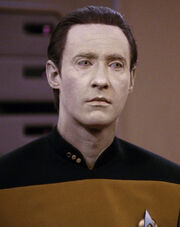
Lieutenant Commander Data in 2366
In 2366, the Enterprise-D was contacted by Sheliak Corporate for the first time in 111 years. In a recorded message, set on repeat broadcast from the Shelia system, they demand that on Tau Cygna V, a planet that was ceded to the Sheliak from the Federation in the Treaty of Armens has been discovered to contain a Human colony. The Sheliak insist they be removed before they arrive at the planet, or the Humans will all be killed. Data – immune to the deadly hyperonic radiation that exists on the planet – was ordered to take a shuttle craft and land at the planet and prepare the colonists for evacuation. Unfortunately, the colony's leader Gosheven was both far too stubborn and nostalgic for all his ancestors' accomplishments on the planet to agree to leave even after several attempts to persuade him or other colonists, even with the help of Ard'rian McKenzie, one of the few reasonable colonists. Eventually, through a demonstration of the firepower of a Type 2 phaser, Data was able to finally convince the colonists to leave, thereby saving over 15,000 Humans from certain death. (TNG: "The Ensigns of Command")
In late 2366, Data was apparently killed when the shuttlecraft he was using to ferry hytritium, desperately needed to neutralize contamination of the water on Beta Agni II, exploded en route from the freighter Jovis to the Enterprise-D. In fact, Data had been abducted by the owner of the Jovis Kivas Fajo, who had added Data to his collection of "rare and valuable" items – which, now besides Data, included a Lapling, a Roger Maris Baseball card, and a Varon-T disruptor. Fortunately, Data, with the assistance of Fajo's partner Varria, as well as the arrival of the Enterprise, was able to escape the Jovis; the unanticipated ease with which the hytritium purified Beta Agni II's water suggested that the contamination had been man-made, leaving the crew suspicious of Fajo – and, after hearing the computer's description of only a part of Fajo's collection, they had concluded that Data could be considered a "rare and valuable object", leading them to the possibility that Data had not been on board the shuttle when it exploded. Upon Data's return to the Enterprise-D, Fajo was arrested. Data had previously mentioned to Fajo his ability to use deadly force and had it not been for the functioning of the Enterprise transporter retrieving Data from the Jovis, Data would have successfully shot and killed Fajo with the Varon-T disruptor, in retribution for Fajo previously having killed Varria with it and through a cold, logical decision that all nonlethal options had been exhausted. (TNG: "The Most Toys")
When later that year, Captain Picard was captured and assimilated as Locutus by the Borg, Data was instrumental in not only rescuing Picard from the Borg, but also in finding a way to destroy the Borg cube approaching Earth by "put[ting] them all to sleep," accessing the command codes that controlled regeneration and convincing the Borg that they all needed to regenerate, thus shutting the ship down and triggering a feedback loop that caused the cube to self-destruct. (TNG: "The Best of Both Worlds, Part II")
A year later, in early 2367, Data, under the control of Dr. Soong, took control of the Enterprise and commandeered it to the planet of Terlina III. Unfortunately, the same program had activated in Lore's positronic brain, and brought Lore to Soong's lab as well. Soong explained he had brought Data because he had created an emotion chip for him, and that he had thought Lore to be dead. Lore incapacitated Data, and Soong mistakenly implanted the chip in Lore instead. After obtaining the chip under these false pretenses, Lore attacked Soong and escaped. Soong died shortly afterward, his last words being to assure Data that Data would grieve for him in his own way. In return, Data called Soong "Father" for the first time. (TNG: "Brothers")
Data once more took command of the ship later that year when, with the Enterprise trapped in a Tyken's Rift, the crew began to suffer from lack of REM sleep, causing to the organic crew of the Enterprise-D the loss of concentration and to perceive hallucinations. The brainwaves of the crew were being affected by a ship trapped on the other side of the rift, whose crew was attempting to communicate with the Enterprise, but Data's android nature and his inability to sleep or dream rendered him immune. Along with Counselor Troi, Data freed the ships by releasing hydrogen; which when combined with a substance carried by the other ship released enough energy to collapse the rift. (TNG: "Night Terrors")
During the blockade of the Klingon-Romulan border during the Klingon Civil War in 2368, Data was placed in command of the USS Sutherland. Despite the first officer being hostile to his android nature, the Sutherland managed to detect the cloaked Romulan ships trying to supply the forces of Duras. Once back aboard the Enterprise, Data submitted himself to Captain Picard and recommended he be disciplined for disobeying the direct order of a superior officer, but was instead praised by Captain Picard for his ingenuity in discovering the cloaked Romulan convoy: "Starfleet does not want officers who blindly follow orders." (TNG: "Redemption II")
Later that year, alien entities took control of the minds of Data, Deanna Troi and Miles O'Brien. The three insisted the Enterprise conducted a systematic survey of the polar region of a moon; a notion Captain Picard, Commander Riker and the rest of the crew considered absurd. When Riker questioned their reasoning, the three staged a violent revolt and took control of the ship. It was later determined by the command crew that the three were controlled by the "spirits" of deceased criminals from Ux-Mal, and eventually the spirits left the Enterprise for their banishment on the moon. Though Data had no control over his actions while under the control of the Ux-Mal criminal, he nonetheless apologized for his behavior toward his fellow officers. (TNG: "Power Play")

Data's head
In late 2368, the Enterprise crew was summoned to San Francisco to evaluate a discovery of extraterrestrial life on Earth that dated back to the late 19th century. They were shocked to discover Data's head, old, dusty, and dead, had been found among the ruins of some 19th century artifacts. When La Forge concluded that the only species capable of time travel and of assuming Human form existed solely on the planet Devidia II, the Enterprise set course for the planetoid.
Data's head would have been about 475 years old when it was finally re-attached to his body in 2369.
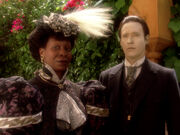
Data meeting Guinan on Earth in 1893 after he had seen her picture in a local newspaper
Arriving at Devidia II, Troi psionically sensed lifeforms, but none were seen to be physically present. Since Data was the only hope for controlling the distortion in phase displacement, he beamed down and soon disappeared, reappearing in the San Francisco of the late 1800s. He quickly adapted to his surroundings and set out to build a sensory device to sense the Devidian time-shifts in order to ultimately return to the 24th century and the Enterprise-D. Shortly thereafter, he incidentally met Guinan, who was hiding out from her father on Earth at the time.
Seeking to recover Data, the senior staff transported to 19th century San Francisco to find him. In a local morgue, Riker and Crusher realized the aliens from Devidia II, disguised as Humans, were slowly killing off the population by appropriating their neural energy and sending it to the 24th century to feed their own people. The Enterprise-D command crew were soon able to find and stop the Devidia II aliens. Even though Data's cranial unit had been severed from his body when he tried to control the Ophidian that controlled their time-travel technology, the crew were able to take Data's body back through the time-rift and use the cranial unit they had recovered from the Presidio mine site to reassemble Data (Data subsequently passing on a message from Picard that Picard had entered into his head in the past with an iron filing to tap out a binary code in his brain). (TNG: "Time's Arrow", "Time's Arrow, Part II")
Later that year, Data and La Forge proposed to connect Data to the ship's systems so he might act as an emergency backup system in case of a ship-wide systems failure. As a result of the experiment, however, Lt. Worf, his son Alexander, and Counselor Troi were trapped in a malfunctioning Old West holodeck program wherein every character physically resembled Data. (TNG: "A Fistful of Datas")
The event was recalled by Beckett Mariner and Brad Boimler in 2381 when she suggested that they bury the evil computer AGIMUS, rather than taking him with him, "like Data's head." Boimler, corrected Mariner stating "actually, Data's head was in a cave, and it's our duty to respect sentient life. (LD: "Where Pleasant Fountains Lie")
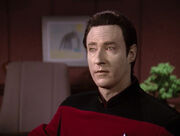
Data wore a command division uniform when Jellico made him XO
Captain Edward Jellico briefly took command of the Enterprise while Captain Picard participated in a covert mission in Cardassian space. Jellico came into conflict with Commander Riker and eventually relieved Riker of duty. Being next in the chain of command after Riker, Data took the position of first officer until Captain Picard's return. (TNG: "Chain of Command, Part II")
In early 2370, he was among the away team that beamed down to the Ohniaka III outpost, whose distress call the Enterprise had responded to. On the surface, Data experienced his first emotion while fighting off a Borg drone, violently beating the drone against the wall. With the captured drone Crosis, Data took a shuttlecraft and left the Enterprise. Captain Picard and an away team tracked Data down and were shocked to find him under the influence of his brother Lore, who had directed the Borg's attacks as part of an attempt to win Data to his side. Lore modified the chip so it could remotely instill anger and hatred in Data. Confused with his new emotions, and with his ethical program deactivated, Data betrayed the crew of the Enterprise, resulting in the capture of Picard, La Forge and Troi. Fortunately, La Forge was able to instruct Picard in modifying a Borg interlink transceiver to reset Data's ethical program with a kedion pulse, restoring his sense of right and wrong; he would still experience negative emotions, however, he could at least choose whether or not to act upon them. With Data's ethical program reactivated, and Riker and Worf leading a rescue attempt with the help of the drone Hugh (who had spent time aboard the Enterprise earlier that year) Picard and his team were able to reactivate Data's ethical program and Data subsequently shot Lore, recovering the emotion chip while Lore was later dismantled. (TNG: "I Borg", "Descent", "Descent, Part II")
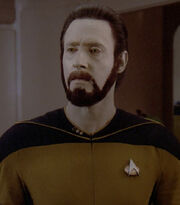
Data with a beard
Later that year, with Captain Picard presumed dead and Commander Riker missing in action, Data assumed command of the Enterprise once more, in an effort to find those responsible for Picard's apparent death and Riker's capture. Even though he was lower in rank, Lieutenant Worf was appointed as acting first officer instead of Lieutenant Commander La Forge, but Worf and Data came into a confrontation when Worf questioned his orders openly in front of the crew on a number of occasions. (TNG: "Gambit, Part I", "Gambit, Part II")
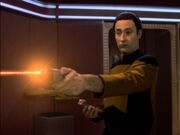
Data fires his phaser at Riker in 2370
After being sent to recover a crashed probe, Data lost his memory and sought refuge with primitive villagers nearby. He was quickly assimilated into the village and given the name "Jayden" by the villagers. However, the radioactive material from the probe that he was transporting was a danger to them. Even without his memory, Data, through observation and scientific method, discovered it was the metal he had brought with him that was the cause. Once he had the radioactive metal secured to prevent further harm, he came up with an antidote that would completely reverse the effects and while being confronted by the fearful villagers, dumped it into the local water supply. In their ignorance, they killed "Jayden" and buried him, but turned his grave into a commemorative monument in his honor after they realized his cure had saved them. Data was later retrieved by Commander Riker and Dr. Crusher, repaired and his memory was restored aboard the Enterprise, although his time on the planet was lost in turn. (TNG: "Thine Own Self")
Shortly after the incident, La Forge found behavior nodes in Data's positronic net and he thought that an alien "archive" was using Data to create different people and that this transformation was still going on. Counselor Troi added that Data was experiencing the android equivalent of "multiple personalities" and that it was indeterminate how many would emerge. Picard later confronted Data, through whom the D'Arsay Sun God of Masaka now spoke, wearing the mask of Korgano. Masaka thought she was alone and did not have to share the sky with anyone when Korgano told her that without him she was not complete. Korgano soon convinced Masaka was getting tired to brighten the sky forever. Masaka replied Korgano should begin the hunt again, and at that moment Masaka fell asleep. When Picard asked Data whether he was all right, Data answered he was not entirely certain what happened and wondered if he had been dreaming again. (TNG: "Masks")
Return to the emotion chip

Data laughs, his emotion chip installed
In 2371, at the ceremony honoring Worf's promotion to Lieutenant Commander, Data witnessed an incident where Worf was "accidentally" sent into the water in a holographic simulation of a ship at sea. Misinterpreting the laughter it evoked, he then spontaneously pushed Dr. Beverly Crusher overboard. He was disheartened to find out that it wasn't quite as amusing as he had assumed. The incident led him to think his development had reached an impasse. This influenced Data's decision to install the emotion chip he had acquired from Lore previously that year.

Data sings a song while scanning for lifeforms
The results were unpredictable and later attributed to the overload of new and unfamiliar emotion. During an away mission with Geordi La Forge on board the Amargosa observatory, his recall of previous humorous incidents led to the emotion chip overloading, fusing into his neural net (much to La Forge's annoyance) and rendering Data helpless as Tolian Soran sneaked on board and kidnapped La Forge. Unable to deal with the sudden onset of fear as a result, Data curled up in a corner as Soran beamed away with La Forge. As the Enterprise investigated, Data was overcome by yet another emotion: Regret, over getting La Forge captured. Captain Jean-Luc Picard, himself trying to get over news of the death of his brother and nephew, helped Data get through his anguish, and the two managed to figure out where Soran was headed, and why.

Data celebrating after the victory at Veridian III

Data protecting Troi from falling debris on the Enterprise bridge
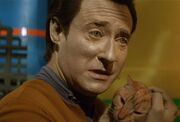
"I am happy to see Spot, yet I am crying."
Upon arrival at planet Veridian III, where Soran was planning to implode the Veridian sun with a trilithium missile so that Soran could enter the Nexus, Data was finally able to experience relief as Geordi La Forge was returned to Enterprise unharmed. Data continued to work on controlling his emotions throughout the mission, Enterprise's battle with the Duras sisters, and the crash landing of the saucer section on Veridian III. By the end of the mission, when Starfleet came to recover the Enterprise crew and anything that could be salvaged from the saucer section, Data reckoned to have experienced 261 distinct emotional states. He learned one more emotion before leaving Veridian III: Tears of joy, after finding Spot alive in an empty barrel. ( Star Trek Generations )
During the crash, Data utters a severe profanity, his first.
By 2373, Data had developed the ability to activate and deactivate his emotion chip at will, since he had learned how to better control its function and integration into his positronic net. ( Star Trek: First Contact )
The Enterprise-E

Data captured by the Borg in 2373
Data transferred to the new USS Enterprise-E in 2372, along with most of the senior staff of the Enterprise-D. In 2373, the Enterprise took part in the Battle of Sector 001, against Starfleet orders. Thanks to the ship's intervention, the Borg cube was destroyed, but not before it launched a sphere, which generated a temporal vortex and time-traveled to the year 2063. The Enterprise pursued, and destroyed the sphere with quantum torpedoes preventing its forecast mission to prevent the first flight of Zefram Cochrane aboard the Phoenix warp ship. Along with Captain Picard and Dr. Crusher, Data beamed down to the surface, to inspect any damage to the Phoenix. Upon suspecting a Borg presence aboard the Enterprise, however, Picard and Data transported back to the ship. While fighting off the Borg near main engineering, Data was captured and brought before the Borg Queen. Instead of attempting to assimilate Data, she embarked on a transformative process to make Data more "Human," by attaching Human skin onto his android skeleton.
When it appeared impossible to deter the Borg any longer, Picard was persuaded by Lily Sloane to initiate the self-destruct of the Enterprise and he ordered all remaining crew to evacuate. However, Picard went to Engineering to find Data and to force the Queen, whom he had encountered several years previously when he was Locutus, to release Data. Picard even declared that he was prepared to take Data's place at the Queen's side and become her equal. However, Data stated he did not wish to go, even after the Queen ordered him away. Data then canceled the auto-destruct sequence and restored computer control; even as Picard begged him not to, the android gave one quick glance to his former commander, before walking past him as if he was nothing. Thus, the Queen ordered Picard's assimilation (Data assured her that Picard would "make an excellent drone"), but not before witnessing the destruction of the Phoenix by Data.

Data altered by the Borg Queen
However, his "assimilation" had all been a ruse – the quantum torpedoes fired by Data missed the Phoenix by the smallest of margins, and quickly thereafter Data ruptured a plasma coolant tank (the Queen had been too busy taunting Picard to notice his approach to it), releasing plasma coolant – which would dissolve organic material on contact. Picard was able to escape, but the Queen – or, at least, that version of her – was killed, pulled into the coolant by Data as she tried to take Picard down with her. Helping Data standing up (with the Borg-given skin melted away, but his mechanical parts undamaged, the android admitted that he didn't feel as bad as he must look), Picard asked him if he was ever tempted to join the Borg's cause. Data replied that, for 0.68 seconds, he was. He added that, for an android, that is "almost an eternity." ( Star Trek: First Contact )
The Ba'ku mission

Data on the Ba'ku planet
In 2375, while assigned to a United Federation of Planets / Son'a duck blind operation on the Ba'ku planet, Data discovered a cloaked holoship submerged in a picturesque Ba'ku lake. The ship was intended as a means to relocate the Ba'ku people from their home world without their knowledge, clearing the way for the mining of metaphasic radiation from the planet's rings. Upon discovery of the cloaked ship, Data was fired upon by a Son'a weapon.
The attack resulted in minor physical damage to his neck and some of his memory engrams, causing Data's memory loss fail-safe system to activate. Data's ethical and moral subroutines asserted themselves over all his basic functions. Effectively, Data had entered a self-preservation mode in which "all" he knew was right and wrong. Before he was finally subdued by Captain Jean-Luc Picard and Lieutenant Commander Worf, Data had revealed the duck blind to the Ba'ku people, and had warned them that the Federation / Son'a presence was a threat – and attacked Ru'afo's flagship with the mission scout ship he hijacked.
The Enterprise crew was able to piece together what had happened – and staged an insurrection against the Federation-Son'a partnership. Data joined some of his crew mates as they defended the Ba'ku on the surface from aggressive Son'a abduction attempts. Later, Data attacked the Son'a flagship with a scoutship, firing tachyon bursts into the shield grid and forcing the ship to rotate its shield harmonics. This allowed the transport of the Son'a ship's crew off their bridge and onto the cloaked holoship.
During his time on Ba'ku, Data reflected on never having been a child. He became friends with Artim and learned how to play. ( Star Trek: Insurrection )
Final days
By 2379, Data was expected to succeed Commander Riker as first officer following Riker's promotion to captain of the USS Titan. En route to Betazed for the second phase of Riker's wedding to Counselor Troi, the Enterprise discovered B-4, one of the three prototype Soong-type androids Data had learned about years earlier, physically identical to him but having a less sophisticated positronic brain. Trying to help him become more Human, Data copied his own memories into B-4's positronic net.

Data sacrifices himself
Before Data could take the role of first officer of the Enterprise, the Enterprise was ordered to Romulus where a new praetor, Shinzon, had come to power. Shinzon's self-asserted good intentions, however, were soon found to be false. In reality, Shinzon was discovered to be a clone of Captain Picard and, due to genetic degeneration, he was in need of Picard's blood in order to restore his life. After Shinzon's vessel, the Scimitar, had all but destroyed the Enterprise, Shinzon planned to eliminate the crew with his thalaron radiation weapon before turning it on Earth. Though Picard was able to defeat Shinzon in hand-to-hand combat, Picard was trapped aboard the Scimitar due to damage to the Enterprise transporters. With no other option, Data elected to physically jump into the vacuum of space through a hull breach in the forward section of the Enterprise – and force his way aboard the Scimitar from the outside. Proceeding to the Scimitar bridge, Data utilized a prototype emergency transport unit concealed in his forearm, to return Picard to the Enterprise. With the thalaron radiation weapon seconds away from firing, Data used his phaser to destroy it, which resulted in the complete destruction of the Scimitar – and Data as well.
As the Enterprise crew mourned the loss of their fallen comrade, Captain Picard tried to explain Data's uniqueness to B-4, though to the captain's dejection, the android did not understand. However, B-4 soon began to quietly sing the same song Data had previously sung, "Blue Skies", at the Riker wedding to himself. Though Data was gone, perhaps his memories would continue to live on. ( Star Trek Nemesis )
Legacy
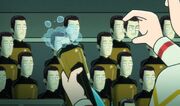
A crate containing bottle of Commander Data limited edition bubble bath
At some point later in his career, Data was commemorated with a limited edition bubble bath; the bottle of which bore his likeness, wearing a late 2370s uniform. A Lore edition was also released and its head could be surreptitiously substituted for that of Data's. (LD: "An Embarrassment Of Dooplers")

Data as he appeared in Picard's dream
Despite the android's best effort, Data's attempts to copy his own memories into B-4's positronic net ultimately failed, and as a result most of Data's positronic net was lost. B-4 was ultimately disassembled and preserved at the Daystrom Institute's Division of Advanced Synthetic Research. (PIC: "Remembrance")
Data also briefly appeared to the Zhat Vash in the Admonition, an ancient storehouse of preserved memories on the planet Aia left behind by the Aia natives which warned about the dangers of intelligent synthetic life.
Approximately fifty years after his construction, Noonien Soong's son Altan Inigo Soong, assisted by Bruce Maddox, successfully created the Coppelius androids via the fractal neuronic cloning of one of Data's positronic neurons. Multiple androids were created as offspring of Data, including Beautiful Flower, Jana and twins Dahj and Soji Asha, who were also eventually created based on the likeness of his painting Daughter. (PIC: "Broken Pieces")

Data painting in Picard's other dream
Captain, and later Admiral, Picard continued to remember Data fondly. During his retirement, Picard had a series of recurring dreams in which he played poker with the android aboard the Enterprise-D. In 2399, Picard had a dream of witnessing Data painting Daughter in the Picard family vineyards after he met Dahj. (PIC: "Remembrance", "Broken Pieces")
Simulation
"You wanted me to do you a favor."
"Yes, sir. When you leave, I would be profoundly grateful if you terminated my consciousness."
"You want to die?"
"Not exactly, sir. I want to live, however briefly, knowing that my life is finite. Mortality gives meaning to Human life, Captain. Peace, love, friendship, these are precious because we know they cannot endure. A butterfly that lives forever... is really not a butterfly at all."

The simulated Data prepares for the end
Despite the destruction of Data's physical form, the memories he uploaded into B-4 before his death as well as a single neuron were used by Bruce Maddox and reconstructed by Altan Soong, the biological son of his creator and "brother", to allow Data's consciousness to continue to exist in a massively complex quantum simulation. Because he had died after the upload to B-4, it was impossible for him to remember his death as that was not part of those memories, but he was aware of the death of his physical body and the circumstances in which he gave his life for Picard. Just as with Lore and B-4, Data considered Altan to be his brother as well.
In 2399, Data encountered the consciousness of Jean-Luc Picard while his memories were in the process of being uploaded to Soong's golem. The two had a discussion in which Data confirmed he did not regret sacrificing his life for Picard and that he was aware of Picard's love and affection for him.
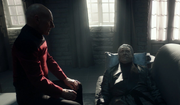
The simulated Data's final moments
As Picard was preparing to leave the simulation, Data made one last request to his old friend – that Picard terminate his consciousness. He explained to Picard that the finite nature of Human life helped define and give it meaning. Once Picard left the simulation, he complied with Data's request. As he deactivated the simulation, Picard postulated that despite the "violence and corruption and willful ignorance" of Humanity, Data was still able to see kindness, curiosity, and greatness of spirit possessed within the Human race, motivating his desire to be a part of the Human family. Data spent the time he had left enjoying a glass of wine, listening to "Blue Skies" on a record player, then reclining on a sofa until he rapidly aged and passed with a simulated Captain Picard, just as he was during the years on the Enterprise-D, by his side. (PIC: "Et in Arcadia Ego, Part 2")
Personal interests
Holodeck adventures
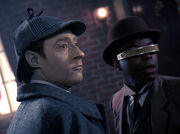
Data and La Forge in a Sherlock Holmes holonovel
Data was fond of Sherlock Holmes and enjoyed playing the great detective in a holodeck program, often accompanied by Geordi La Forge in the role of Dr. Watson. (TNG: "Elementary, Dear Data", "Ship in a Bottle")
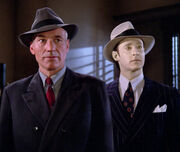
Picard and Data in "The Big Good-Bye"
Data also twice accompanied Picard in his holonovels of the Dixon Hill series, playing "Carlos, from South America," one of the private eye's associates. (TNG: "The Big Goodbye", "Manhunt")
Data had been known to play poker with people from other time periods, including Stephen Hawking, Albert Einstein, and Sir Isaac Newton, out of interest as to how they would interact in such a situation. He called the exercise "most illuminating". (TNG: "Descent")
The arts
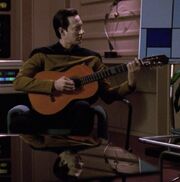
Data playing the guitar in 2368
Data pursued many of the higher arts of Earth. He developed his painting skills, creating art of many styles and subjects. (TNG: "Birthright, Part I", et al.) He performed in plays and wrote poetry, although his lack of emotions meant that his poems commonly focused more on accurate poetical structure without the content evoking any kind of emotional reaction. (TNG: "Schisms", "The Defector", "Frame of Mind", "Emergence") He played the violin and performed on several occasions. (TNG: "Sarek", "Tin Man", et al.) He also played classical guitar and the oboe. (TNG: "Silicon Avatar", "In Theory") He dabbled in singing, most notably performing "Blue Skies" at William T. Riker and Deanna Troi's wedding. ( Star Trek Nemesis )
Personal relationships
Friendships
Data maintained close relationships with most of the Enterprise senior staff – during his time aboard the Jovis, after La Forge's furious refusal to accept that Data himself was somehow responsible for the shuttlecraft explosion that supposedly killed him, Riker told Captain Picard that, for someone incapable of emotion, he certainly evoked them strongly in others around him. (TNG: "The Most Toys")
Jean-Luc Picard
Data regarded Picard as something of a father figure throughout his service, asking for Picard's advice on numerous occasions in his quest to become more Human. Picard always gave Data advice whenever he could.
A similar relationship between a captain and an artificial member of the ship's crew was developed in Star Trek: Voyager between Captain Kathryn Janeway and The Doctor, Voyager's Emergency Medical Hologram, who achieved sentience after he was forced to assume the permanent position of Voyager's doctor after the deaths of the original medical staff.
Following Tasha Yar's death in 2364, Data was puzzled about her death, thinking not about Yar but rather how he would subsequently feel in her absence, thinking that he missed the purpose of her memorial but Picard assured him that he understood the purpose of the memorial perfectly. (TNG: "Skin of Evil")
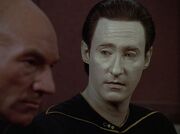
Data discussing his rights with Picard
In 2365, Data's existence was threatened when Commander Maddox wished to disassemble and study Data to gain a better understanding of how his positronic brain functioned. Data refused to submit to Maddox's procedure, finding his research flawed but Maddox claimed that Data was property of Starfleet and therefore not a sentient being and as a result had no choice other than to submit to the procedure. Captain Louvois supported Maddox's claim and Picard intervened by challenging their reasoning, saying that Data was indeed sentient and deserved the freedom to make his own decisions. He also said that Data represented an entire race and that forcing him to submit to Maddox's procedure was tantamount to slavery – strictly prohibited under Federation law. Ultimately, Louvois sided with Picard's standpoint and agreed that Data, android or not, was indeed sentient and entitled to the same rights as any other Starfleet officer. (TNG: "The Measure Of A Man")
In 2367, Picard's seemingly unbreakable trust in Data was tested when Data refused to fully co-operate in an investigation into a number of events that happened within a 24-hour time span although Data claimed that the time span was only thirty seconds. Data's intransigence threatened to end his Starfleet career and even his own existence but it was later revealed that Captain Picard was himself responsible for Data's unusual behavior after an encounter with the Paxans in a T-Tauri type star system. (TNG: "Clues")
During the Klingon Civil War from 2367-8, the Federation made an indirect intervention with a blockade of Starfleet vessels placed in formation to use the pioneering tachyon detection grid in an effort to expose Romulan support for the House of Duras. Picard assigned all of his senior officers positions on board other ships except for Data. Data questioned Picard about why he was not assigned command of a vessel considering that there was a severe lack of senior officers available for the mission, wondering if he felt that his being an android made him unsuitable for command. Picard, slightly embarrassed by Data's question, assigned Data command of the USS Sutherland. During the blockade Data disobeyed direct orders from Captain Picard and was able to expose the Romulan's involvement in the war. Data submitted himself for disciplinary action for disobeying a direct order from his superior officer but Picard praised Data for not following his orders as he believed that doing so was appropriate under the circumstances. (TNG: "Redemption II")
In 2369, Data refused to allow a group of exocomps to be sacrificed in order to save the lives of Captain Picard and Lieutenant Commander La Forge, who were trapped on board the Tyrus VIIA station, believing that they were sentient and therefore capable of making their own decisions. After agreeing to a compromise suggested by Commander Riker, the exocomps were released and able to save the lives of Picard and La Forge. Picard understood the predicament that Data was faced with as he had defended Data's sentience just a few years previously but this time the exocomps had no advocate and Data felt compelled to act on their behalf. Picard considered Data's actions to be the most "Human" decision that he had ever made. (TNG: "The Quality of Life")
Later that year, following an accident in main engineering that activated a dormant program in his positronic brain, Data sought advice from several officers, including Captain Picard, on his "visions." Picard was curious why Data was studying thousands of different cultures to interpret his visions. Data said that he had no culture of his own but Picard told Data that he did have a culture; a culture of one and that its validity was no less than that of a billion. Picard suggested that Data should consider what the visions meant to him instead of what they meant to other people. (TNG: "Birthright, Part I")
After a malfunctioning emotion chip fused with Data's positronic net in 2371, Data felt guilty for not saving La Forge from capture by Tolian Soran on board the Amargosa observatory. Data was overwhelmed by emotions and requested being shut down until the chip could be removed. Although Picard felt sympathy for Data, he told him that part of having emotions was integrating them into your life and learning to live with them and denied Data his request. ( Star Trek Generations )
In 2373 (when the Enterprise-E traveled back to the year 2063 on Earth), Picard and Data initially went down to the planet to observe the damage the Borg had done to Zefram Cochrane's missile complex in Montana. Down in the missile silo of the Phoenix, Picard, upon touching the missile that would make history by becoming the first Human starship traveling at warp, explained to Data that sometimes a touch can make objects more "real." Upon suspecting Borg presence aboard the Enterprise, Picard and Data transported back to the ship. Fighting off the Borg near main engineering, Data was soon captured and brought to the Borg Queen. Instead of attempting to assimilate Data, the Queen made him physically more Human by attaching Human skin onto his android skeleton.
When it appeared impossible to hold off the Borg any longer, Picard was convinced to initiate the Enterprise's auto-destruct sequence and ordered all remaining crew to evacuate. He himself went on to engineering to find Data and to convince the Queen, who he had encountered several years previously, to let Data go. Picard was even prepared to take Data's place at the Queen's side, willingly, thus becoming her equal. However, Data claimed he did not wish to go; even after the Queen ordered him away. Thus, the Queen ordered Picard's assimilation, but not before witnessing the destruction of the Phoenix by Data.
Data fired a spread of quantum torpedoes but they missed by the smallest of margins, and quickly thereafter he burst a plasma coolant tank, releasing plasma coolant, which would liquefy organic material on contact, killing the Borg. The Queen was killed, but Picard survived. While helping Data to his feet, Picard asked him if he was ever tempted to join the Borg's cause. Data, hinting at his kiss with the Queen, replied that for a fraction of a second (zero point six eight seconds), he was. He added that for an android, this brief moment was like an eternity. ( Star Trek: First Contact )
Following the wedding of William Riker and Deanna Troi in 2379, Data was confused by Captain Picard's mixed feelings for the couple – although the captain was happy that Riker was due to accept promotion to the rank of Captain and take command of the USS Titan and that his new wife was to transfer over to the Titan and take position as the ship's counselor, Picard was somewhat saddened by their departure and tried to explain to Data that experiencing feelings of both happiness and sadness at the same time are common in these situations.
At the climax of the Battle in the Bassen Rift, Data jumped across the void of space from the Enterprise-E to the Scimitar, saving Picard by using a prototype emergency transport unit but he sacrificed his own life to save the crew of the Enterprise by firing at the thalaron radiation generator and so destroying the Scimitar. Following the battle, Captain Picard held a toast with the Enterprise-E's senior officers as a tribute to their fallen comrade. ( Star Trek Nemesis )
Twenty years after Data's death in the Bassen Rift, Picard encountered Data's preserved consciousness in a complex quantum simulation. As Data's sacrifice had greatly weighed on Picard's mind after all this time, Data reassured Picard that he did not regret sacrificing his life to save Picard. Before Picard was brought back, Data asked Picard for a final favor in terminating his consciousness, as he wished to live knowing that his life was finite. Picard honored the request. (PIC: "Et in Arcadia Ego, Part 2")
William T. Riker
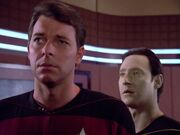
Data with Riker in 2364
William Riker first met Data on the Enterprise holodeck in 2364. Data was trying to whistle "Pop Goes the Weasel", but could not finish the last few notes. At Data's memorial service, Riker could not remember what song Data was trying to whistle. ( Star Trek Nemesis ) Riker helped him finish the tune, later giving Data the nickname "Pinocchio", in reference to Data's wish to become Human. At first, Riker was skeptical about Data's abilities as a machine, assuming his rank of lieutenant commander was merely honorary. Despite Riker's misconception, Data had earned his rank, just as every other Starfleet officer of the same rank and above had done. (TNG: "Encounter at Farpoint")
In 2365, Data's status as a sentient individual came into question. A hearing was held on Starbase 173, but the base lacked a complete legal staff. As first officer of the Enterprise, Riker was forced to act as counsel for Bruce Maddox and was given the task of convincing Judge Phillipa Louvois that as an android, Data was the property of Starfleet. Riker very nearly proved that Data was property by means of deactivating him. Picard's defense later made Louvois hold that Data was a machine, was not the property of Starfleet, and had the right to choose whether to comply with Maddox's requests to study him. Riker was distressed over the incident, and he felt terrible that he had nearly cost Data his rights. Data did not hold any ill will towards Riker or Maddox; on the contrary, Data was actually grateful that Riker participated, telling Riker that if he did not, the initial ruling being appealed would have remained in Maddox's favor, and by Riker going against his conscience and potentially condemning his friend and colleague to be disassembled, that action wounded him in order to save Data's life, and was something Data would never forget. (TNG: "The Measure Of A Man")
Data sought Riker's help and advice on several occasions. One instance was when he asked for Riker's advice on friendship and betrayal, following a mission involving Ishara Yar in 2367. (TNG: "Legacy") Data also asked for Riker's help when Keiko Ishikawa temporarily called off her wedding to Miles O'Brien in 2367. (TNG: "Data's Day") He came to Riker once more for advice when he started to date Jenna D'Sora. (TNG: "In Theory")
Geordi La Forge
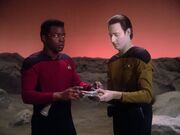
Data assists Geordi La Forge with his VISOR on Vagra II
Data's closest friend during his time aboard the Enterprise was Geordi La Forge. As of 2367, Data considered La Forge to be his best friend. (TNG: "Data's Day") Because Data was an android, La Forge was better equipped to effect repairs and maintenance on him than was Dr. Crusher as chief medical officer. Their long-term friendship dated back to 2364, when both were assigned as bridge officers aboard the vessel. La Forge's promotion to chief engineer the next year reflected his expertise with machinery, though he experienced difficulties in establishing relationships with other people, especially women. These personality traits may have accounted for La Forge's ability to so easily maintain a relationship with a sentient machine such as Data; that being said, La Forge never saw Data as an android or a machine per se, but as a close friend and treated him no differently than he would have if Data were a sentient biological organism. ( Star Trek Generations ; TNG: "Encounter at Farpoint", "Code of Honor", "Booby Trap", "Galaxy's Child", "Eye of the Beholder")
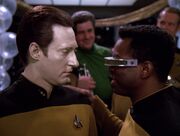
Data with La Forge at his memorial service
Their friendship was tested in early 2370, during the Enterprise's encounter with the individualized Borg. Lore used the emotion chip stolen from Dr. Noonian Soong to influence Data to join him, deactivating Data's ethical program and transmitting negative emotions (such as hatred, sadism, and anger) to Data. While under Lore's influence, Data participated in a neurological experiment with La Forge as the primary subject. The experiment caused La Forge a great deal of pain and would have eventually resulted in La Forge's death. Fortunately, Captain Picard and others of the Enterprise crew were able to reactivate Data's ethical program. It was Data's friendship with La Forge that eventually allowed the android to overcome his brother's influence. (TNG: "Descent, Part II")

La Forge reluctantly agreeing to install Data's emotion chip
In 2371, following an incident on the holodeck in which Data pushed Dr. Crusher off a sailboat in the water, Data decided to finally have the emotion chip Dr. Soong gave him years earlier installed in his neural net. La Forge assisted Data by installing the chip after the latter made this life-changing decision, though La Forge later reacted negatively to his friend's erratic behavior that accompanied the initial acquisition of emotions. When La Forge was later threatened by Dr. Soran aboard the Amargosa observatory, Data was afraid to intervene, but he later learned to live with his newly acquired emotions. ( Star Trek Generations ) When Data secretly transported himself to the Scimitar to save Picard, La Forge helped him do it, knowing this would be the last time the friends would see each other. ( Star Trek Nemesis )
Beverly Crusher
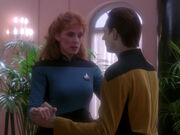
Crusher teaching Data to dance
Dr. Beverly Crusher and Data had a special relationship, with Data seeking advice from Crusher on subjects ranging from parenting (TNG: "The Offspring") to dancing. She taught Data to tap dance, not knowing that he had intended to learn how to dance for the wedding of Miles O'Brien and Keiko Ishikawa. (TNG: "Data's Day") Data also came to her for advice on whether or not to consider the exocomps alive, and she was present when Data learned they were indeed sentient. (TNG: "The Quality of Life")
As the ship's chief medical officer, Dr. Crusher had some knowledge of how to repair and "heal" Data, though mostly it was Geordi La Forge who filled that function, since Data was an artificial lifeform. (TNG: "Datalore", "The Game")
In 2369, Data incorporated a subroutine for small talk. At the recommendation of Captain Picard, he studied Commander Hutchinson while the Enterprise underwent a baryon sweep at Arkaria Base. Dr. Crusher was the first person Data tried to engage in small talk using his observations of Hutchinson, to her astonishment and delight. (TNG: "Starship Mine")
During Worf's promotion ceremony in 2371, Dr. Crusher tried to explain to Data the humor behind Worf being dunked after walking the plank on the holodeck recreation of the sailing ship Enterprise. Data did not completely understand and then pushed Crusher into the water, as an attempt at the same type of humor. However, Dr. Crusher and the rest of the senior staff did not find it nearly as amusing. La Forge later recommended that Data stay out of sickbay for a few days following the ceremony. ( Star Trek Generations ) In 2379, Dr. Crusher remarked that she thought Data had nicer eyes than his predecessor, B-4. ( Star Trek Nemesis )
Worf
Data enjoyed an excellent professional relationship and a solid, if low-key, friendship with the cantankerous Klingon. They had two important things in common: first, both were rescued by the Federation after their homes were destroyed by enemy attacks, instilling in each of them a high regard for the Federation's ideals. Second, both were Starfleet pioneers; Data and Worf were, respectively, the first android and Klingon Starfleet officers. Although most of their time together was in the line of duty (such as bridge duty and away missions), both were frequent participants in the senior staff's poker games, and they often spent time together off-duty in Ten Forward. Moreover, Worf was one of the only people that Spot, Data's cat, warmed up to, even though Worf was not fond of the feline.
When Data's shuttlecraft exploded while returning to the Enterprise-D in 2366, all Worf could do was stare in shock at the viewscreen and mutter his friend's name. As it turned out, the explosion was staged in order to kidnap Data, and he was subsequently rescued. (TNG: "The Most Toys")
In 2367, Data sought Worf's help in finding a wedding present for Miles and Keiko O'Brien. (TNG: "Data's Day")
When Geordi La Forge and Ensign Ro Laren were presumed dead in a transporter accident in 2368, Data volunteered to arrange the memorial service, but he was unsure about what kind of ceremony to have and asked Worf for advice. Worf told him that for Klingons, an honorable death in the line of duty was a cause for celebration, not mourning. Data took his advice and arranged a very upbeat party, giving people the chance to share their pleasant memories of the 'deceased'. His arrangments were very well received by the crew, and was only enhanced when La Forge's and Ro's states were returned to normal. (TNG: "The Next Phase")
A year later, Data again sought Worf's guidance, this time in researching the "dreams" he was having. Worf, preoccupied with rumors that his father had survived the attack on Khitomer, gave Data some cryptic answers, but Data seemed to understand what he was saying and went on his way. Data later returned this favor when Worf learned that the apparently returned Kahless the Unforgettable was actually a clone of the legendary Klingon; Data's reflections about how, after learning of his android nature, he chose to consider himself a person who could progress and grow over time rather than a machine who would never be more than the sum of its parts, convinced Worf to accept Kahless as the symbol that he could be for his own people rather than define him by the circumstances of his origins. (TNG: "Birthright, Part I", "Rightful Heir")
Their friendship was severely tested in 2370 when Data, acting as commanding officer, privately admonished Worf for challenging his orders in front of the bridge crew. Afterward, Data apologized to Worf if the dressing-down had ended their friendship, but Worf took the high road, saying that if the friendship was in jeopardy, it was his fault alone. After that exchange, their working and personal relationship quickly returned to normal. (TNG: "Gambit, Part II")
Katherine Pulaski
When Dr. Pulaski came aboard the Enterprise in 2365, she was not very kind toward Data, because of her discomfort with technology. She saw him as no more than a machine, pronouncing his name "DAT-uh" rather than "DAY-ta," and did not understand that he had a preference. (TNG: "The Child") She was also condescending towards Data and often spoke to him through other crewmembers. (TNG: "Where Silence Has Lease") She believed that Data's methodical way of looking at situations meant that he could never solve a traditional Sherlock Holmes mystery, which led to the creation of the program which brought about the sentient Professor Moriarty. (TNG: "Elementary, Dear Data")
However, later during the year, she began to value Data and look upon him as an equal and as a sentient individual. The major turning point was during the crisis surrounding the Darwin Station children. Data stayed to support Pulaski for a long period of time after she had become infected, something for which she was very grateful. (TNG: "Unnatural Selection") Pulaski even challenged master Zakdorn strategist Sirna Kolrami to a game of Strategema, believing that Data could win. When Data was unsuccessful, he interpreted it as a possible weakness and relieved himself of duty. Dr. Pulaski talked to Data and made him realize that one letdown did not necessarily mean total failure and encouraged him to return to duty, but with no success. Finally, Captain Picard told Data that a loss can be had with no mistakes made and convinced him to return to duty. Data later forced Kolrami to a stalemate, much to Kolrami's chagrin. (TNG: "Peak Performance")
Children
Tasha Yar observed that Data viewed the world with the wonder of a child. During his service Data had befriended several children. Data befriended an alien girl named Sarjenka in violation of the prime directive. To mitigate the damage, Picard ordered Dr. Pulaski to erase Sarjenka's memory. (TNG: "Pen Pals") Data befriended a ten-year-old boy named Timothy after Timothy was orphaned in the explosion that destroyed the Vico. Timothy wanted to be incapable of emotion like Data because he wrongfully blamed himself for the Vico's destruction, so he pretended to be an android and attempted to mimic Data in every way. (TNG: "Hero Worship") Data befriended an alien girl named Gia when he lost his memory on Barkon IV. This friendship was similar to his friendship with Sarjenka, only this time, it was Data who lost all memory of the friendship, and the child who would never forget him. (TNG: "Thine Own Self")
Spock
As an unemotional member of the crew, and a respected advisor to the captain, Data shared many similarities to Spock on board the first USS Enterprise. However, where Spock often believed himself to be superior to Humans, Data aspired to be more Human (Data once stated that having no emotions made him closer to Vulcans than Humans, but he found their stark philosophy to be limited). The contrast between the two was instantly apparent to them when they met on Romulus. Spock noted that Data's complete lack of emotion and superior physical capabilities were qualities to which Vulcans aspired, but Data wished to be more Human. Data noted that as a half-Human, Spock abandoned what Data had sought his entire life by choosing the Vulcan way of life. (TNG: "Unification I", "Unification II")
Romance
Data was programmed with multiple techniques and was "fully functional." Data had a sexual relationship with Natasha Yar during the influence of polywater intoxication and attempted a romantic relationship with Jenna D'Sora in late 2367. (TNG: "The Naked Now", "In Theory") In 2373, the Borg Queen seduced him in an attempt to convince Data to join the Borg's cause. ( Star Trek: First Contact )
Natasha Yar
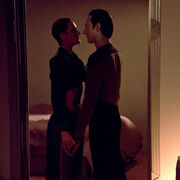
Tasha Yar and Data under the influence of polywater intoxication in 2364
Data had a short sexual relationship with Natasha Yar in 2364. Yar was at least slightly attracted to Data and had sex with him while under the influence of polywater intoxication. She later told him that the incident "never happened." (TNG: "The Naked Now") Data, since he has perfect memory (he can remember everything that has ever happened to him like it just happened), still felt a special connection to Tasha. He kept a holographic image of Tasha to remember her. When Data's rights as a sentient being were called into question, his romantic encounter with Tasha was a strong influence for Judge Phillipa Louvois to rule that Data was in fact a sentient lifeform. (TNG: "The Measure Of A Man") La Forge and Wesley Crusher found the holoimage when they visited Data's quarters after his apparent death in 2366. (TNG: "The Most Toys")
Jenna D'Sora
In late 2367, Lieutenant Jenna D'Sora found herself in love with Data. After she expressed her affection for him by kissing him on the lips, Data asked his friends for advice on what to do, and decided to pursue the relationship. Since he had no real emotions or feelings, Data created a special program in his neural net to guide him through the intricacies of love. However, as his relationship with Jenna progressed, Data discovered that in romance, the logical course is not always the most appropriate.
Later that year, they decided to end their relationship. D'Sora explained that her previous boyfriend had been unemotional, and felt that her choice of Data, an android completely incapable of emotion, indicated a pattern. Without a second thought, Data, seeing the validity of her point, agreed to discontinue his program. (TNG: "In Theory")
Data's comment to the Borg Queen in Star Trek: First Contact regarding how long it had been since he had last made use of his sexual functionality seems to indicate he was referring to his liaison with Tasha Yar. This implies that Jenna and Data were never physically intimate during the course of their relationship.
Borg Queen
In 2063, during the Borg attack on the Enterprise-E, which had arrived from the year 2373, Data was abducted by a Borg drone. Unable to assimilate the android, the Borg Queen attempted to bribe Data into subservience by offering him live flesh instead of his polymer. Data played along, having suggested sexual relations with the Borg Queen, who wanted him as a partner to ease the loneliness of her role as the one individual in the Collective, Data essentially 'replacing' Locutus. Data ultimately betrayed the Borg Queen, killing her with warp engine coolant, which also removed the new flesh she had grafted onto him. He subsequently admitted to Picard that a part of him was still sorry about her death, noting that her offer to bring him closer to Humanity had briefly tempted him (albeit for only 0.68 seconds, a duration that, according to Data, equates – for an android – to "nearly an eternity"). ( Star Trek: First Contact )
Alternate realities and timelines
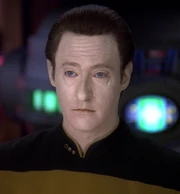
An alternate timeline where Data has blue eyes instead of his normal yellow.
In 2366, the USS Enterprise-C emerged from a temporal rift. Its disappearance from the year 2344 caused an altered timeline, where the Federation was losing a war against the Klingons. Data was still the ship's operations officer. (TNG: "Yesterday's Enterprise")
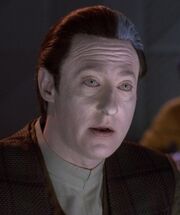
Data in an unknown future timeframe
Lieutenant Worf encountered a quantum fissure which caused him to begin shifting between quantum realities in 2370. In several universes, Data was still the Enterprise's operations officer, and attended a surprise birthday party for Worf. In at least one of these realities, Data's eyes were blue instead of their characteristic yellow.
In another reality, Data was still the operations officer and second officer but was outranked by Commander Worf, who served as the ship's first officer under Captain Riker, Picard having been lost in the Battle of Wolf 359 in 2367. He determined that the Worf from the primary reality did not belong in his reality as his quantum signature was not consistent with the resonance of matter in the rest of the universe and that he had originated from a different quantum universe. This version of Data theorized that it would be possible to seal the fissure if the shuttlecraft Curie from the primary reality re-entered the fissure and emitted a broad spectrum warp field. According to Captain Picard, the Data from the primary reality had reached the same conclusion. All the events following Worf's encounter were erased from the timeline once the fissure was sealed. (TNG: "Parallels")
In an unknown, alternate future timeframe, Data was a professor (the Lucasian Professor of Mathematics) at Cambridge University and lived at Isaac Newton's house with a housekeeper and several cats. Apparently in this future, he had grasped the concept of humor, stating that his housekeeper Jessel made him laugh. In addition, his everyday speech had much more nuance and inflection, and he appeared to have finally mastered the use of contractions. He had also dyed part of his hair grey as he believed that it made him look distinguished. However, Jessel was of the opinion that it made him look like a "bloody skunk." (TNG: "All Good Things...")
Holograms

Data as part of The Three Musketeers
Data was holographically duplicated on a number of occasions.
- Lt. Reginald Barclay in 2366 recreated at least two Datas when he was suffering from holo-addiction. One program had Data as part of The Three Musketeers, while the other recreated the entire crew of the Enterprise-D. That recreation of Data was present when Barclay said goodbye to his fantasies and deleted the programs. (TNG: "Hollow Pursuits")
- Barash recreated the entire command crew of the Enterprise-D in 2367 on Alpha Onias III to keep Commander Riker there. This recreation took place in a 2383 where Data had been promoted to Commander and had become the first officer. (TNG: "Future Imperfect")
- A computer malfunction aboard the USS Enterprise-D while the holodeck was running the "Ancient West" Deadwood program resulted in all the characters taking on the appearance of Data in 2369. (TNG: "A Fistful of Datas")
Chronology
- ca. 2336
- Built by Dr. Noonian Soong and his wife Juliana on Omicron Theta.
- 2338
- Discovered by the crew of the USS Tripoli.
- 2344
- Permitted to enter Starfleet Academy.
- 2348
- Graduated from Starfleet Academy as an ensign.
- 2350s
- Served aboard the USS Trieste.
- 2351
- Promoted to lieutenant.
- 2363
- Promoted to lieutenant commander. Assigned as operations officer aboard the USS Enterprise-D.
- 2364
- Discovered his first brother, Lore, on Omicron Theta.
- 2366
- Constructed his own daughter, Lal, aboard the Enterprise.
- 2368
- Given command of the USS Sutherland during the Klingon Civil War.
- 2372
- Reassigned as operations officer aboard the USS Enterprise-E.
- 2379
- Discovered his second brother, B-4, on Kolarus III; killed in the destruction of the Reman warbird Scimitar.
- 2399
- Revived, consciousness from B-4 downloaded into a complex quantum simulation. Subsequently, conscience was terminated and thus was killed again.
|
| ||||||||||||||||||||||||||||||
|
| ||||||||||||||||||||||||||||||
Appendices
Appearances
- TNG: Every episode except "Family" (in "Frame of Mind" as a hallucination)
- Star Trek films:
- Star Trek Generations
- Star Trek: First Contact
- Star Trek: Insurrection
- Star Trek Nemesis
- ENT: "These Are the Voyages..." (voice only)
- PIC:
- "Remembrance" (dreams only)
- "Broken Pieces" (vision only)
- "Et in Arcadia Ego, Part 1" (vision only)
- "Et in Arcadia Ego, Part 2"
- LD: "An Embarrassment Of Dooplers" (bubble bath bottle design)
Background information
Data was played by actor Brent Spiner in all of the character's television and film appearances. The character of Data appeared in all episodes of Star Trek: The Next Generation, with the exception of season four's "Family". He also appeared in all four TNG-era Star Trek films. In 2005, Spiner recorded a brief, voice-only cameo as Data for the final episode of Star Trek: Enterprise, "These Are the Voyages...": Data was heard speaking to Deanna Troi over a com-link (for which Spiner was not credited). Spiner had previously played Arik Soong, an ancestor of Data's creator, in a 2004 story arc on Enterprise. In 2020, Data appeared in four episodes of Star Trek: Picard, albeit only in dreams and visions and as a version of Data's personality downloaded into B-4 prior to the actual Data's death in Nemesis.
According to the Star Trek: The Next Generation Companion (2nd ed., p. 15), Data was inspired by The Questor Tapes, a movie created for television created by Gene Roddenberry and Gene Coon during the 1970s. It featured Robert Foxworth as the title character (as well as including Majel Barrett and Walter Koenig), and was intended as the pilot for a series which would have detailed the adventures of an android with a childlike personality.
However, Susan Sackett felt Data was more consciously inspired by Spock than by Questor. She commented, "Gene was always fascinated by artificial intelligence. Data was sort of like the Spock character who could be logical and see things in a different way. The difference is this one wants to be Human, unlike Spock, who did not want to be Human. I don't think he was consciously thinking of The Questor Tapes." (The Fifty-Year Mission: The Next 25 Years, p. 58)
The Vulcan character of Xon from the aborted Star Trek: Phase II television series has also been noted as a "forerunner" or "early version" of Data, including by Judith and Garfield Reeves-Stevens. (Star Trek Phase II: The Lost Series, p. 28) In particular, they highlighted the similarity of the two characters' efforts "to replicate human behavior without being able to understand it." (Star Trek Phase II: The Lost Series, p. 83)
Wherever Roddenberry's thoughts lay in creating Data, Robert Justman concurred that such an android character would be a boon for the series. "I thought we could establish a new series 'regular' – an android programmed by Starfleet Command with all of the familiar abilities and characteristics of Spock fused with the leadership and humanistic qualities of Captain Kirk," Justman recalled. "A new character like this would give us any number of dramatic or humorous avenues." (The Fifty-Year Mission: The Next 25 Years, p. 58)
Rick Berman observed that Data was similar to multiple other fictional characters. "He was a little like the characters in The Wizard of Oz," Berman pointed out. "He wanted to be a real boy, like Pinocchio, but he also he wanted to have a heart, wanted to have a brain." (The Fifty-Year Mission: The Next 25 Years, p. 96)
According to Melinda M. Snodgrass, Data wasn't just similar to characters from child fiction but was extremely child-like himself. "I've always used Data as the child," Snodgrass commented. "Data is exploring what any child does as they grow up. You can allow Data to make a mistake, learn from it, and rectify it in a way that if you have someone else to make that mistake, it seems unbelievable because these are such highly trained professionals." (The Fifty-Year Mission: The Next 25 Years, pp. 96-97)
The March 1987 TNG Writers/Directors Guide provided a backstory for Data that was jettisoned rather quickly during the series. In that version, he had been manufactured by highly advanced, but never seen, aliens who placed into him all the memories of a doomed "Earth-Asian" space colony to preserve their existence. His personality would thus have been influenced by the colonists. Elements of this backstory, such as Data retaining the memories of a group of colonists, survive in a version of his backstory established in "Datalore".
Robert Justman reckoned there were "several ways to go" when casting Data and took inspiration, in this regard, from actor Lance Henriksen's portrayal of the android Bishop in the film Aliens. (The Fifty-Year Mission: The Next 25 Years, p. 58) Among the performers who were considered to portray Data were John Lone, Robert Englund, actress Kim Miyori (Creating the Next Generation), Mark Lindsay Chapman, Kevin Peter Hall, Eric Menyuk, and Kelvin Han Yee. The latter four were being considered as of 13 April 1987, at which point Chapman was regarded as seemingly the favorite choice for the part. [1]
When Brent Spiner won the part of Data, he was anxious about how much it would allow him to do. "Initially when I took the part, my biggest fear was that it was going to be the most limited character, not only on the show but on television, because the canvas on which I was being allowed to paint was such a narrow one," Spiner explained. (The Fifty-Year Mission: The Next 25 Years, p. 96)
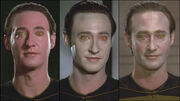
Becoming Data, bit by bit
When Gene Roddenberry cast Brent Spiner in the part of Data, the android's appearance was not yet determined. Spiner went through thirty-six makeup tests, as makeup artist Michael Westmore painted him an enormous variety of colors, including bubblegum pink and battleship gray. The preproduction personnel finally settled upon bright gold, with yellow irised contacts. Spiner was opposed to the idea of wearing makeup for his character at first. "My argument with Gene was, 'If you could make a creature that moves like this and looks like this and thinks like this, why can't you do the skin?' And Gene's response was, 'What makes you think what you have isn't better than skin?' And that's very difficult to argue with." (Trek: The Next Generation Crew Book)
In his portrayal of Data, Brent Spiner drew his inspiration from two different sources. The first was taken from Riker's reference to Data as Pinocchio in "Encounter at Farpoint", a comparison which he used in his portrayal. "He's a machine who'd love to be Human, and is fascinated by Humans," Spiner observed. "I suppose in his journey he'll get closer and closer to being one." The second was the Blade Runner character Roy Batty, as according to Spiner, "I like to think of myself as the Rutger Hauer of this show," adding, "but then I like to think of myself as Rutger Hauer in real life: strikingly handsome, irresistible to women, an intergalactic enigma." (Trek: The Next Generation Crew Book)
Brent Spiner's portrayal of Data had an effect on the number of stories featuring him, as Rick Berman pointed out: "Brent was so good at it that all the writers felt a great desire to want to write for that character." As a result, Spiner himself was delighted to find his "biggest fear", that Data would be quite a limited role, wasn't being realized. "It was incredible for me [....] I just lucked into a part that turned into the most unlimited role on television," Spiner enthused. (The Fifty-Year Mission: The Next 25 Years, p. 96)
In "The Questor Tapes," Questor was to have experimented with sexuality, making love to a female character. Network censors did not allow this scene to be used in the film, but a decade later, more relaxed standards allowed an "intimate relationship" to occur between Data and Tasha Yar in "The Naked Now". Data's assurance that he is a "fully functional" Human male is a quote from the telemovie. A scene from "The Royale" wherein Data repairs loaded dice is also from The Questor Tapes. [2]
The ending for Star Trek Nemesis suggested that B-4 may become a replacement for Data, thus possibly becoming Data in the process and mirroring Spock's rebirth and the allusions to it at the end of Star Trek II: The Wrath of Khan . However, Spiner noted that he had visibly aged out of the role and that it would be implausible for him to continue playing an android whose appearance should not change with time (though the seventh-season episode "Inheritance" establishes that Data has an aging program that ages his appearance, and "All Good Things…" shows an appearance-aged Data). Hence, B-4's presence (and the suggestion that he has a copy of Data's memories stored) was most likely meant to have been a tease.
Other than in alternate realities, Data has always appeared as a lieutenant commander throughout the entire run of TNG and the subsequent movies. Jean-Luc Picard and Beverly Crusher are the only other characters to remain at the rank they started with. Data was also one of the few non-Vulcans to master the Vulcan nerve pinch on-screen, as seen in "Unification II" and Star Trek Nemesis .
A reference to Data is made in the VOY Season 2 episode "Prototype" by B'Elanna Torres when she is conversing with Automated Unit 3947. While assisting him in developing a prototype robot capable of using a uniform power module, Torres describes Data as the only truly sentient artificial life-form in her culture while 3947 reflects that he would be interested to meet a machine with equal status to a "Builder".
On 9 April 2008, the character of Data was inducted into Carnegie Mellon University's Robot Hall of Fame. Attending the ceremony on the android's behalf was Spock actor and Carnegie Mellon alumni Zachary Quinto. [3]
In 2016, Brent Spiner expressed a willingness to pass on the portrayal of Data, saying, "I don't think I'll get proprietorial about it. I'd like to see Tilda Swinton play Data. Don't you think that'd be cool?" (SFX, issue 275, p. 67)
Academy graduation inconsistency
In "Encounter at Farpoint", Data says he graduated with the Starfleet Academy Class of '78, despite the facts that the episode took place in 2364 and Data was assembled in the late 2330s. In the extended cut of "The Measure Of A Man", it was established that Data was admitted to the Academy in 2344 and graduated in 2348. Later, for his personnel file in "Conundrum", these dates were changed to 2341 and 2345.
Use of contractions
Data's tendency to avoid the use of verbal contractions in ordinary speech is remarked upon in "Datalore" and "Future Imperfect". While episodes preceding "Datalore" routinely show his use of contractions, this rule was adhered to for most of the remainder of the series with some notable exceptions. These can be categorized in one of three broad ways: as a single instance not commented upon during the episode, as part of portraying a new character or persona, or to denote some future change or enhancement to his original programming.
- In "Encounter at Farpoint", Data tells McCoy, "I'm an android," and later, about Q, he says, "At least we're acquainted with the judge."
- In "Where No One Has Gone Before", he says, "It's off the scale," when referring to the ship's velocity and "We're here…" as an explanation as to why the Enterprise should stay and study the galaxy M-33.
- In "The Arsenal of Freedom", after destroying one of several weapons, Data says to Yar, "must've".
- In "Manhunt", when Captain Picard summons Data to Lwaxana Troi's boudoir to help him escape from an awkward situation, Data replies, "I'm on my way."
- In "Elementary, Dear Data", Data asks La Forge to open the door to the drawing room, saying, "Let's not keep the inspector waiting."
- In "Shades of Gray", Data says to La Forge, "I'm always careful." He also appears to say "you're" seconds later.
- At the end of "Datalore", Data tells Wesley Crusher, "I'm fine," and in "We'll Always Have Paris", he makes the remark, "It's me."
- During the teaser of "The Naked Now", Data uses contractions several times, including "What we've just heard is impossible" and "I'm sure he meant now."
- In "The Last Outpost", Data states, "Captain, this shouldn't be" and "I'm afraid not."
- In Star Trek: Insurrection , he remarks to a child that "You'll be safer." This is said in a rushed, seemingly emotional tone. But is after Data receives his emotion chip.
- In "The Big Goodbye", Data appears to be able to use contractions with ease on several occasions while participating "in character" during the Dixon Hill simulation on the holodeck.
- In "Data's Day", Data says to Troi, "In an effort to be helpful, I'm attempting to calculate the variables of a successful marriage." Later, in the transporter room, Data says, "There's no record…"
- During "In Theory", while creating a new program for use during a romantic relationship, Data utilizes the phrases "Honey, I'm home!", "I'll join you", and "You're not my mother!" When questioned about the last's apparent angry nature, Data reverts to a more characteristic response of "You are not my mother." It is implied that Data was trying to act like "role models" he had found in the ship's computer.
- In "The Next Phase", while telling a transporter chief to use a console on the bridge to scan for energy fields, Data says he will modify an emitter to "eliminate the fields, once they've been isolated."
- In "Time's Arrow", when asked by the bellboy Jack London what the machine he's building is "gonna be", Data responds hesitantly, "What do you think it is… gonna be?"
- In "Inheritance", when updating Commander Riker regarding their status, Data says "we'll be returning to the beam out point shortly."
- For the alternate future timeline version in "All Good Things..." and for all of the TNG films, Data is shown using contractions.
In fact, "Datalore" did not explicitly assert that Data was incapable of using contractions, merely that he generally did not use them, and that his tendency was to "use language… formally." In "The Offspring", Lal's ability to use contractions is depicted as an advancement beyond Data's abilities, but Data's actual words are that he has not "mastered" their use. Given the above instances, it is clear Data is capable of using contractions as an affectation. Perhaps what he had not "mastered" was the ability to use them spontaneously, in everyday speech.
Upon her death in "The Offspring", Data downloads Lal's programming and memory records into his own positronic matrix, so that she need not be completely "lost." Given her apparent "mastery" of spontaneous contraction use during her brief life, this may further explain Data's liberal use of contractions beyond 2366.
In the "Special Crew Profile: Lt. Cmdr. Data" in the TNG Season 6 DVD special features, Data's occasional use of contractions is pointed out as often being an error in the script – the writers would often mistakenly write them in or miss them in edits – or that Spiner would slip up on his lines and use the more natural contraction rather than Data's formal speech patterns.
Apocrypha
Data's backstory from the March 1987 TNG Writer's/Director's Guide made it into David Gerrold's novelization of Encounter at Farpoint.
The graphic novel The Gorn Crisis showed Data during the Dominion War, where he was able to help the Federation forge an alliance with the Gorn in 2375, defeating a Gorn leader in combat and thus demonstrating that Human ingenuity was superior and stronger than the Gorn.
The novel The Buried Age explores Data's first encounter with Picard, with Picard encouraging Data to assert himself and work beyond what his superiors request of him; prior to meeting Picard, Data had shown a lack of career advancement because he always did the job in front of him simply because it didn't occur to him to push himself further or ask for particular assignments over others, adhering to the chain of command without thinking of going beyond the rules. As a result of his actions in the novel, where he uncovers and averts attempts to sabotage the under-construction Galaxy-class starships as an ancient alien implants subtle flaws in their design specs, Data is promoted to lieutenant commander and offered a place on a Galaxy-class ship when they are completed.
The TNG Relaunch novel Resistance follows up the question of whether B-4 would become Data, when Picard and La Forge are forced to deactivate B-4 and send him away for analysis, having accepted that the moments where B-4 showed access to Data's memories were merely random occurrences rather than any sign that he had definitively progressed. However, the later novel Greater than the Sum establishes that the Federation Council overturned the decision and granted B-4 the right to choose his own fate.
Data is resurrected in the novel Cold Equations: The Persistence of Memory, when Doctor Soong – who survived his death by transferring his mind into an android body far more Human in appearance than Data's – transfers Data's memories from B-4 into his own body, unable to complete the new body he had been attempting to construct due to the recent Borg invasion and a sudden attack from the Breen. Although Data does not consider himself to have been "resurrected" – citing, as an example, his reluctance to return to Starfleet now that he possesses his father's memories and understands how Soong felt at the idea of Data not continuing his work – La Forge concludes that he is still Data in every way that matters, citing their continued friendship and Data's predisposition to not use contractions even when capable of doing so as proof.
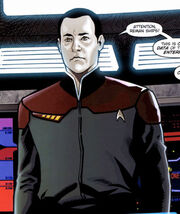
Captain Data of the USS Enterprise-E
The comic book series Star Trek: Countdown, a tie-in to the 2009 Star Trek film, depicts Data as alive in 2387, having successfully imprinted his neural nets onto B-4's programming; at one point, Spock, who was also brought back to life after dying, makes a note of the incredibly unique life experience the two share. In the comic, Data had become captain of the Enterprise-E; along with Captain Picard, his face is seen in the film's comic adaptation, in which the Delta Vega mind-meld scene is depicted with a collage of images from Countdown. This promotion to captain is one of the pieces of trivia that appears on loading screens in Star Trek Online. The short story "Unexpected Honor", appearing in Star Trek Magazine issue 167 (pp. 90-93) in 2012, shows Data's captaincy ending with the Enterprise-E's destruction at the hands of the Undine in 2408; afterwards, Data retires from Starfleet to teach at the University of Oxford, a possible nod to the anti-time future in "All Good Things..." where he also became a university professor after leaving Starfleet.
In the short story Our Million-Year Mission, set a million years in the future, Data Soong is a crewmember aboard the UberEnterprise, a ship populated by holographic replicas of famous Starfleet officers. He has modified himself to be able to experience every nuance of Human emotion as well as many alien ones.
See also
- Jayden, identity while amnesiac
- Carlos, a persona in the holodeck
External links
- Data at StarTrek.com, the official Star Trek website
- Data at Wikipedia
- Data at Memory Beta, the wiki for licensed Star Trek works
- Data at The Star Trek Online Wiki
Colony Where Androids Malfunction and Kill to Protect Movie
Source: https://memory-alpha.fandom.com/wiki/Data
0 Response to "Colony Where Androids Malfunction and Kill to Protect Movie"
Post a Comment